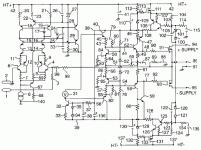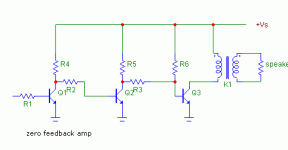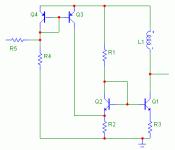Now you've done it!!!
Nelson
I guess he has 🙂.....and after that long winded reply by myself I'll just note that I'm actually getting the parts together to build one of the Aleph-X clones to see what the fuss is all about in the best sense of the phrase.
You'd think aluminum was the close cousin of gold for the cost of heatsinking LOL....(now I know why the electros used to blow up so often, penny wise and pound foolish). The PSU is taken care of with the transformers from a couple of UPS's which committed suicide, casework and components are next.
I'd like to add a personal thanks for all the time you must spend with what we used to call in the trade "time toilets"...us guys with nothing better to do than eat up your time, I appreciate it immensly, thank you.
Kevin
Nelson
I guess he has 🙂.....and after that long winded reply by myself I'll just note that I'm actually getting the parts together to build one of the Aleph-X clones to see what the fuss is all about in the best sense of the phrase.
You'd think aluminum was the close cousin of gold for the cost of heatsinking LOL....(now I know why the electros used to blow up so often, penny wise and pound foolish). The PSU is taken care of with the transformers from a couple of UPS's which committed suicide, casework and components are next.
I'd like to add a personal thanks for all the time you must spend with what we used to call in the trade "time toilets"...us guys with nothing better to do than eat up your time, I appreciate it immensly, thank you.
Kevin
AKSA said:
I'm reminded of Pavel's comment:
The low distortion is necessary, but not [a] sufficient condition
I put it to you that the best amplifiers do add something, but let's not be killjoy about this, let's call it 'harmonic fullness'.
Hugh,
I am afraid that this so called "harmonic fullness" is just a myth. The what is called harmonic fullness when listenning to one guitar quickly changes into disharmonic mismatch when listenning to the philharmonic orchestra. It is impossible to add only so called "pleasing harmonics" to the complex musical signal by means of an amplifier 😉 .
Cheers,
Pavel
Voicing the system, or an amp for that matter, is not an easy task and sometimes the right signature is achieved by a pure accident. But I noticed, that when everything is done right, all types of music sound good. Be it one guitar, philharmonic orchestra or even electronica. In my experience, getting the 70's punk rock to sound right is the hardest to achieve (forget philharmonic tunes)😉
Dear Hugh,
http://users.otenet.gr/~athsam/electrocompaniet.htm
This is classical Otala amp from IEEE transactions, dated back to 1973. Here is the full story:
http://home.online.no/~tsandstr/
halcro US patent 5,892,398 – schematic is below, nothing new, by the way
http://users.otenet.gr/~athsam/electrocompaniet.htm
This is classical Otala amp from IEEE transactions, dated back to 1973. Here is the full story:
http://home.online.no/~tsandstr/
halcro US patent 5,892,398 – schematic is below, nothing new, by the way
Attachments
Peter Daniel said:
But I noticed, that when everything is done right, all types of music sound good. Be it one guitar, philharmonic orchestra or even electronica. In my experience, getting the 70's punk rock to sound right is the hardest to achieve (forget philharmonic tunes)😉
I completely agree with this, Peter. One of my testing CD's is Bridges to Babylon, Stones.
" Nothing new "
To dimitri : What you can to see quite new ? This amp is very well tuned and it is main advantages, certainly except floating voltage in driver stage 😉.
To dimitri : What you can to see quite new ? This amp is very well tuned and it is main advantages, certainly except floating voltage in driver stage 😉.
Dang, I guess I'll just have to go back to designing for 0.005% distortion and high slew and hope like hell that it sounds OK....
Nice to revisit the Electrocompaniet site, Dimitri. Thank you for the link. In one of my periodic OS changes I had lost that 'favorite', and the story is really very interesting.
About ten years ago I designed a 28W zero global feedback tube/mosfet hybrid, a 6SL7 followed by a trick power mosfet, slightly more complex than Pavel's. It's been gathering dust for three or four years now - I only sold six monos - and yesterday I loaned it to a hard-bitten audiophile, a 50 year old EE in fact with a background in electronic music.
It measures about 2% at full power, 98% of it from the tube, nearly all H2 and H3. The output stage PSpices at around 0.05%, mostly H2. It uses lashes of local feedback, of course, but no global feedback. I really need to define what I mean here lest the Kraken wakes.
Julian rang me this morning to say he couldn't believe it; he felt it was the best amp he'd ever heard. He was astonished at the realism on all kinds of music and the complete absence of any amplifier sound of its own.
I don't know about that, because I certainly hear the tube, but I still find it difficult to reconcile the high distortion and the extraordinary resolution, particularly orchestral, of this amplifier.
Perhaps there are a few more things we should be measuring, huh? I'm convinced we only measure half the story, and I know that our ability to measure things creates complacency......
Cheers,
Hugh
Nice to revisit the Electrocompaniet site, Dimitri. Thank you for the link. In one of my periodic OS changes I had lost that 'favorite', and the story is really very interesting.
About ten years ago I designed a 28W zero global feedback tube/mosfet hybrid, a 6SL7 followed by a trick power mosfet, slightly more complex than Pavel's. It's been gathering dust for three or four years now - I only sold six monos - and yesterday I loaned it to a hard-bitten audiophile, a 50 year old EE in fact with a background in electronic music.
It measures about 2% at full power, 98% of it from the tube, nearly all H2 and H3. The output stage PSpices at around 0.05%, mostly H2. It uses lashes of local feedback, of course, but no global feedback. I really need to define what I mean here lest the Kraken wakes.
Julian rang me this morning to say he couldn't believe it; he felt it was the best amp he'd ever heard. He was astonished at the realism on all kinds of music and the complete absence of any amplifier sound of its own.
I don't know about that, because I certainly hear the tube, but I still find it difficult to reconcile the high distortion and the extraordinary resolution, particularly orchestral, of this amplifier.
Perhaps there are a few more things we should be measuring, huh? I'm convinced we only measure half the story, and I know that our ability to measure things creates complacency......
Cheers,
Hugh
Hugh,
we should meet and make a comparative test 😉 😉 . I am afraid that it is quite useless to try to persuade by long-distance experience of somebody else. So let's take it easy, that is probably the only possibility 😉
Cheers,
Pavel
P.S. Czech language does not use definite and undefinite article 😀
we should meet and make a comparative test 😉 😉 . I am afraid that it is quite useless to try to persuade by long-distance experience of somebody else. So let's take it easy, that is probably the only possibility 😉
Cheers,
Pavel
P.S. Czech language does not use definite and undefinite article 😀
Charles,
My way of thinking was:
A zero-feedback amplifier is capable of inaudible levels of distortion at high listening levels, but in this specific instance it did not because the amplifiers were clipping when played back at high levels with those speakers in that room.
I agree with the statement: “A zero-feedback amplifier is capable of inaudible levels of distortion at high listening levels”
Which amplifying stages are zero-feedback stages?
a) Triode stage (common cathode), working on low impedance load (RL<Ri), with cathode resistor shunted by bypassing capacitor (or without cathode resistor at all).
b) Triode cascode stage (common cathode-common grid) under the same conditions
c) Triode-based long-tailed pair under the same conditions
d) Pentode stage (common cathode), working on any load, with cathode resistor shunted by bypassing capacitor (or without cathode resistor at all) and without feedback to the second grid.
I’m sure that one can design amplifier with inaudible levels of distortion using these stages
My way of thinking was:
A zero-feedback amplifier is capable of inaudible levels of distortion at high listening levels, but in this specific instance it did not because the amplifiers were clipping when played back at high levels with those speakers in that room.
I agree with the statement: “A zero-feedback amplifier is capable of inaudible levels of distortion at high listening levels”
Which amplifying stages are zero-feedback stages?
a) Triode stage (common cathode), working on low impedance load (RL<Ri), with cathode resistor shunted by bypassing capacitor (or without cathode resistor at all).
b) Triode cascode stage (common cathode-common grid) under the same conditions
c) Triode-based long-tailed pair under the same conditions
d) Pentode stage (common cathode), working on any load, with cathode resistor shunted by bypassing capacitor (or without cathode resistor at all) and without feedback to the second grid.
I’m sure that one can design amplifier with inaudible levels of distortion using these stages
Peter Daniel said:Voicing the system, or an amp for that matter, is not an easy task and sometimes the right signature is achieved by a pure accident. But I noticed, that when everything is done right, all types of music sound good. Be it one guitar, philharmonic orchestra or even electronica. In my experience, getting the 70's punk rock to sound right is the hardest to achieve (forget philharmonic tunes)😉
PMA said:I completely agree with this, Peter. One of my testing CD's is Bridges to Babylon, Stones.
🙄
The Bridges to Babylon is one excellently (amazingly at the moments) recorded album (nice piece of music anyway) that among the firsts sounds well probably on any system. It is not punk and it is not from seventies.
Pedja
I will try to build an amp that avoids all kinds of feedbacks for the output devices, even no use of followers maybe.
No feedback, no distortion

No feedback, no distortion

>I will try to build an amp that avoids all kinds of feedbacks for the output devices
Let us discuss how will you do it...
Let us discuss how will you do it...
Bernhard said:I will try to build an amp that avoids all kinds of feedbacks for the output devices, even no use of followers maybe.
Might be worth starting a new thread for, if you go ahead, there are too many distractions in this one 😉
And what more - the circuit is single ended (according to single-ended nature of the air) and its distortion is subtracted from speaker's distortion, resulting in zero distortion chain (including air distortion). Scientific paper supporting this topology would be highly appreciated.
Dear Dimitri,
I am sorry, but I know more than perfectly the result of the circuit like this even with current sources.
I am sorry, but I know more than perfectly the result of the circuit like this even with current sources.
dimitri said:Dear Hugh,
http://users.otenet.gr/~athsam/electrocompaniet.htm
This is classical Otala amp from IEEE transactions, dated back to 1973. Here is the full story:
http://home.online.no/~tsandstr/
Another copy of the Otala/Lohstroh amplifier appeared in the Netherlands a couple of years later. It was the JK acoustics Mono Block Active 1 from Johan Ketelaar. See http://www.jkacoustics.nl/ClassicsActiveIMk1.htm This also was a famous amplifier. In the early eighties I borrowed one from a local HiFi shop and took it completely apart in the weekend to look at what was inside. It appeared to be a copy of the Otala/Lohstroh amplifier, although with other transistors (input differential with 2SC1775A, second differential with BD237, differential VAS stage with BD237 and BD238, drivers with 2SD718 and 2SB688 and output stage with 3 times 2SC2565 in parallel and 3 times 2SA1095 in parallel). I still have the complete hand drawn copies of the PCB layout and the schematics derived from the layout. I must have thought, now that I have a chance to look inside, better do it good. Anyway, I never did anything with it. When I recognized the design, for me the fun was over. 😉
Steven
- Status
- Not open for further replies.
- Home
- Amplifiers
- Solid State
- Feedback artifacts, cars and semantics


